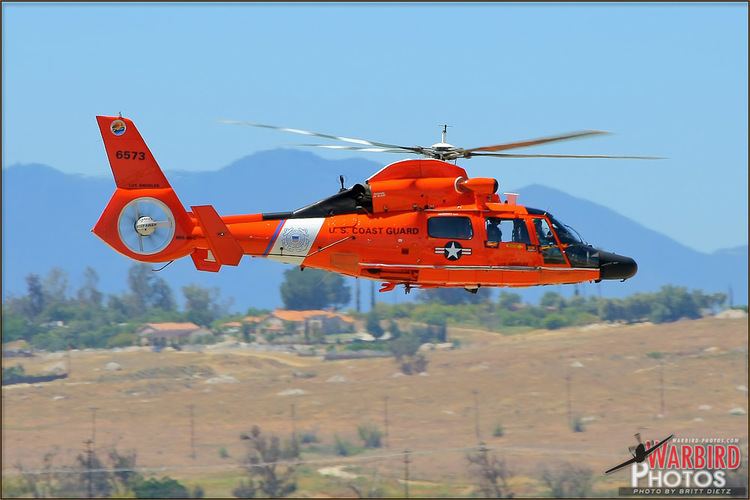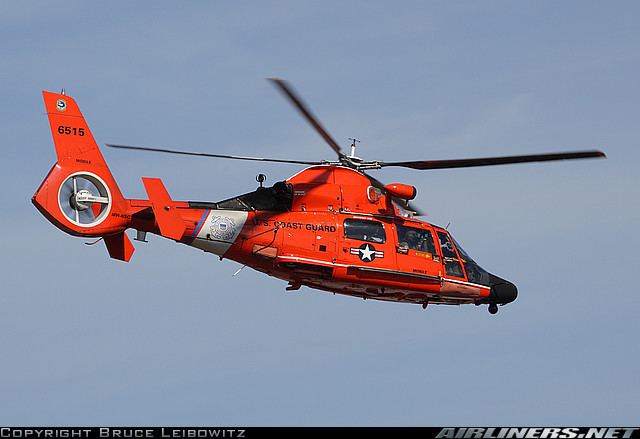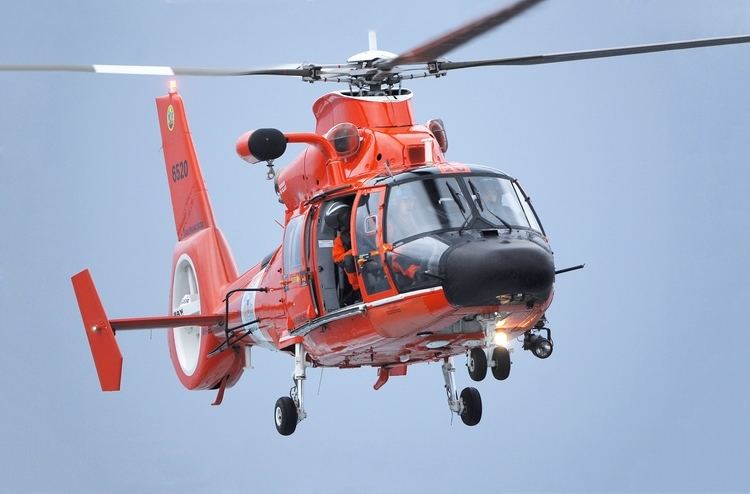Top speed 217 km/h Weight 3,128 kg Unit cost 9,000,000–9,000,000 USD | Range 658 km Length 12 m Engine type Turbomeca Arriel | |
 | ||
Manufacturers Airbus Helicopters, Aérospatiale | ||
The Eurocopter HH-65 Dolphin is a twin-engine, single main rotor, MEDEVAC-capable search and rescue (SAR) helicopter operated by the United States Coast Guard (USCG). It is a variant of the French-built Eurocopter AS365 Dauphin.
Contents
- Eurocopter hh 65 dolphin
- Development
- Design
- Operational history
- Israeli Air Force service
- Variants
- Operators
- Specifications MH 65C
- References

Eurocopter hh 65 dolphin
Development

The SA366 G1 Dauphin version was selected by the United States Coast Guard in 1979 as its new short range recovery (SRR) air-sea rescue helicopter, replacing the Sikorsky HH-52A Sea Guard. In total 99 helicopters, optimised for the USCG's search and rescue role tasks and given the designation HH-65A Dolphin, were acquired. Unlike the HH-52, the HH-65A is not able to perform water landings. The HH-65 normally carries a crew of four: Pilot, Copilot, Flight Mechanic and Rescue Swimmer.

The Dolphin was manufactured by Aerospatiale Helicopter Corporation (later American Eurocopter) in Grand Prairie, Texas. Textron Lycoming's LTS101-750B-2 turboshaft engines were selected for the twin engine powerplant whilst Rockwell Collins manufactured the HH-65's electronic systems in Cedar Rapids, Iowa.

The HH-65 Dolphin is used for homeland security patrols, cargo, drug interdiction, ice breaking, military readiness, pollution control, and search and rescue missions. The HH-65 is known for its Fenestron tail rotor and its autopilot capabilities, which can complete an unaided approach to the water and bring the aircraft into a stable 50 ft (15 m) hover, or automatically fly search patterns, an ability which allows the crew to engage in other tasks.

In order to comply with U.S. regulations relating to local content (based primarily on the value of individual components of the aircraft), engineering changes were required—notably, the SA365's original Turbomeca Arriel engines were replaced with LTS101-750B-2 powerplants, which at the time were required to be American. Unfortunately, initial teething problems with this engine worsened as the HH-65's weight grew, resulting in several in-flight loss-of-power events. The USCG funded a program to improve engine reliability, but the resulting LTS101-850 failed to meet expectations.

In 1994, the USCG therefore held a fast-track competition to select a new powerplant, and in March 2004 the Guard announced the selection of the Turbomeca Arriel 2C2-CG, already installed on the EC155. This upgrade began in 2004, and has resulted in a safer and more capable aircraft. These modified HH-65As and HH-65Bs, which also gained new avionics and other enhancements, have been designated as HH-65Cs.
Design
The HH-65A's minimum equipment requirements exceeded anything previously packaged into a helicopter weighing less than 10,000 pounds. Seventy-five percent of the HH-65's structure—including rotorhead, rotor blades and fuselage—consists of corrosion-resistant composite materials. Some Coast Guard pilots have nicknamed the Dolphin as "Tupperwolf", a portmanteau of tupperware (because of the aircraft's high composites content) and Airwolf (from the 1980s TV series).
Also a unique feature of the Dolphin is its computerized flight management system, which integrates state-of-the-art communications and navigation equipment. This system provides automatic flight control. At the pilot's direction, the system will bring the aircraft to a stable hover 50 feet (15 m) above a selected object. This is an important safety feature in darkness or inclement weather. Selected search patterns can be flown automatically, freeing the pilot and copilot to concentrate on sighting & searching the object.
A distinctive feature of the MH-65 is its fenestron ducted-fan anti-torque device. The fenestron consists of 11 blades spin inside a circular housing at the base of the helicopter's tail fin.
Certified for single-pilot instrument flight rules (IFR) operation, the HH-65A was the first helicopter certified with a four-axis autopilot, allowing for hands-off hover over a pre-determined location.
Operational history
The Dolphin is primarily a Short Range Recovery (SRR) aircraft. There are now a total of 102 Dolphins in the Coast Guard Fleet. The fleet has home ports in 17 cities on the Atlantic and Pacific Ocean, Gulf of Mexico, Hawaii, and the Great Lakes region.
The Dolphin is usually deployed from shore but it can be deployed from medium and high endurance Coast Guard Cutters, as well as the Polar Icebreakers. The Dolphin's main jobs are: search and rescue, enforcement of laws and treaties (including drug interdiction), polar ice breaking, marine environmental protection including pollution control, and military readiness.
When deployed from an icebreaker, the helicopter acts as the ship's eyes, searching out thinner and more navigable ice channels. They also have the job of airlifting supplies to villages isolated by winter, or transporting scientists to conduct remote research.
The MH-65 is also used to patrol the Air Defense Identification Zone (ADIZ) around Washington, D.C., also known as the National Capital Region (NCR). Seven new-build MH-65Cs were acquired for this mission.
Israeli Air Force service
In the early 1980s, the Israeli Navy sought to acquire a purpose-built maritime helicopter to bolster its over-the-horizon detection and targeting capabilities. Several helicopter types were evaluated, including the Westland Lynx and SH-60 Seahawk; in 1983, Israel announced the selection of the HH-65 Dolphin. Seeking a few examples to gain service experience and with limited funding, Israel acquired two used HH-65A developmental test aircraft from the USCG, the first HH-65A pre-production prototype (c/n 6002) and the third prototype (c/n 6005). These were delivered on August 4, 1985 and although owned by the navy, they were operated by the Israeli Air Force. Initially serving as the maritime flight of 124 Squadron at Palmachim, in June 1987 the IAF formed a dedicated maritime squadron,193 Squadron, to which the two Dolphins were assigned. On 16 September 1996 one crashed in the Mediterranean, killing the three crew members on board. The remaining helicopter was retired a year later, replaced by the Eurocopter AS565 Panther. The Dolphins were operated by a crew consisting of an IAF Pilot, and IAF mechanic and an IN maritime support officer. First deployed in USCG colors, they were later given a blue and gray color scheme.
Variants
Operators
Specifications (MH-65C)
Data from United States Coast Guard
General characteristics
Performance
Armament
